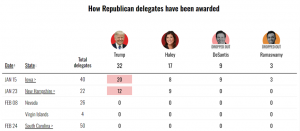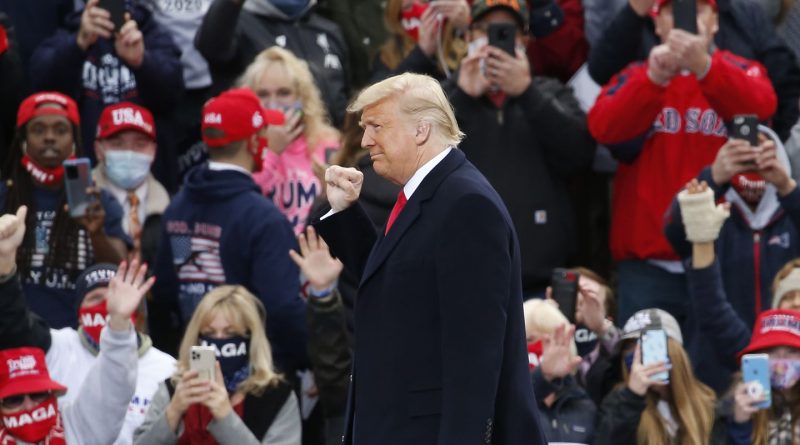Iowa Caucus and New Hampshire Primary: Recap, Analysis, and a Look Towards the Future
Mario Stampone
Staff Writer
It’s officially presidential election season! As is tradition, the Iowa Caucus, held on Monday, January 15th, marked the official start of the Republican presidential primary calendar. Iowa is critical to the presidential primary process because it is the first state to hold a contest, and its results have been vital to propelling candidates forward to be their party’s nominee. Due to its importance, candidates always spend significant money, resources, and time in Iowa ahead of the caucus. This year was no different, as candidates spent over $120 million on ads and traveled to 99 counties across the state.
Although similar in nature, a caucus is different from a traditional primary election. While caucuses and primaries are both ways to choose a candidate for a general election, caucuses are run by political parties on the precinct level. In contrast, primaries are run by state and local governments. Caucuses are restricted to registered members of that party. Depending on the state, primaries can be either open, where voters do not have to be registered with any political party to vote, or closed, where voters can only vote for candidates of the party they are registered with. Caucuses involve voters gathering in their local precinct and voting by either a secret ballot, raising hands, or splitting into groups based on their preferred candidate. Voters can openly voice their opinions, debate about the candidates, and try to sway undecided voters. In a primary, voters anonymously vote for their preferred candidate by secret ballot.
In both caucuses and primaries, voters cast ballots for their preferred nominee, the votes are tallied, and delegates are distributed to candidates based on proportional, winner-take-all, or hybrid systems, which varies by state. In a proportional system, the number of delegates a candidate receives is directly proportional to the percentage of the vote they win. In a winner-take-all system, all delegates in that state are won by the candidate who receives a plurality of the vote. Finally, a hybrid system is where delegates are awarded based on varying factors such as minimum thresholds. Delegates representing their state/district will select the Republican presidential nominee at the Republican National Convention in Milwaukee, Wisconsin, in July. A candidate needs 1,215 delegate votes out of 2,429 to secure the Republican nomination.
Leading up to the Iowa Caucus, the polls showed that former President Donald Trump was the heavy favorite against his GOP challengers, Florida Governor Ron DeSantis, former South Carolina Governor Nikki Haley, and the young entrepreneur-turned-politician Vivek Ramaswamy. Freezing and subzero temperatures and wind chill across the state of Iowa threatened to cast doubt over the results, as turnout fell far below expectations, with only 110,000 voters (15% of registered Republicans) participating. However, the polls were, for the most part, accurate. As expected, Trump, walking into the night as the clear frontrunner of the Republican field, won the Iowa Caucus, capturing the first state in the GOP’s presidential nominating process.
While it was no shock that Trump, who is running his campaign as a de facto incumbent, won the Iowa Caucus, what was vital for the former president was delivering a resounding and convincing win that would help to quickly dispatch his GOP rivals, consolidate the party base around him, and allow him to shift his focus to defeating President Biden in November’s general election. Leading up to the Iowa Caucus, the question was whether Trump would clear 50% of the vote. He did just that. In a landslide, Trump won 51.0% of the vote, capturing 20 of the state’s 40 delegates. Trump’s margin of victory was almost 30 points over second-place Ron DeSantis (21.2% and nine delegates), which smashed the previous record for margin of victory from a non-incumbent in the GOP Iowa Caucus. The previous record was set way back in the 1988 Iowa Caucus when Sen. Bob Dole beat Pat Robertson by almost 13 points. In a distant third was Nikki Haley, who won 19.1% of the vote and eight delegates. Rounding out the field was Vivek Ramaswamy, who had 7.7% of the vote and three delegates.
Impressively, Trump won 98 of Iowa’s 99 counties, losing only Johnson County, a more Democrat-friendly area, to Nikki Haley by a single vote. It was also notable that Trump drew strong support from voters who identified as White evangelicals and very conservative, which were groups he lost in 2016. Questions about electability due to his legal troubles and possible conviction were largely dismissed by voters, as Trump won widespread support and improved with all demographics.

As the night went on, key dominos began to fall. As votes were coming in and it became clear that he had no path to the nomination, Vivek Ramaswamy announced that he would drop out of the presidential race and endorse Donald Trump, citing the need for an America First candidate. In his victory speech, Trump praised his primary challengers and called for unity. Days later, Ron DeSantis announced his intention to suspend his 2024 presidential campaign right before the New Hampshire primary. DeSantis would also endorse his rival, Donald Trump.
A week after the Iowa Caucus, the first traditional Republican presidential primary election was held in the state of New Hampshire, with 22 delegates at stake. Since 1975, New Hampshire has had a law requiring their primary to be held at least a week before any other primary. The people of the Granite State take great pride in this tradition, even amidst controversy from the Democratic side, as voters headed to the polls to cast their ballots. The battle for the Republican nomination was now a two-person race between Donald Trump and Nikki Haley. Leading up to the primary, Ramaswamy joined Trump on the campaign trail in New Hampshire. After a disappointing third-place finish in the Iowa Caucus, Nikki Haley remained hopeful, believing that she was heading into friendlier territory in New Hampshire. New Hampshire’s open primary system and moderate electorate were advantages for Haley.
After all the votes were tabulated, Trump won 54.3% of the vote and 13 of New Hampshire’s 22 delegates. This was despite almost half of the state’s electorate being comprised of independent voters and only about a third of voters identifying as “MAGA.” Haley only won 43.2% of the vote, making this race an 11-point victory for the former president. This was a good night for Trump because New Hampshire elected the eventual Republican nominee in 2008, 2012, and 2016, the last three competitive GOP presidential election cycles. Additionally, a record-breaking turnout of over 324,000 votes helped Trump set a New Hampshire primary record for the most votes ever won by a candidate in either party, with an astounding 176,000+ votes. Trump won voters who said immigration and the economy were their most important issues, while Haley won voters whose major concerns were abortion and foreign policy. Overall, the New Hampshire primary was a favorable result for Trump, as Haley’s path to the nomination continues to shrink.
With the Iowa Caucus and the New Hampshire primary in the books, Trump now has two decisive wins under his belt. Notably, these are wins from two states that are very different from one another. At this point, Nikki Haley and her campaign are in a rough spot, and her path to securing the Republican nomination is almost obsolete. However, Haley is not ready to bow out of the race just yet, telling her supporters, “This race is far from over.” Perhaps, with Haley’s home state of South Carolina being the site of the next major presidential primary on February 24th, Haley and her campaign believe that she can win and change the trajectory of this primary. However, this seems unlikely, as early state polling shows that Trump has a substantial lead over Haley. Another conclusive loss could be the final nail in the coffin for the Haley campaign.
The results of the Iowa Caucus and the New Hampshire primary have confirmed what many have already come to know and accept. Donald Trump will be the Republican nominee for President of the United States in 2024. Not only this, but it is undeniable that Trump possesses an iron grip on the Republican Party that seems unlikely to dissipate any time soon. There were many GOP primary challengers in this race who tried their best to appeal to the Republican base and become viable challengers to Trump. Some presented themselves as “Donald Trump without all the baggage.” Some attempted to appeal to moderates and independents while shunning the “MAGA” wing of the party. Some quickly arrived on the scene and revealed the potential of what the new-age Republican Party could look like. Some just outright despised Trump and opposed everything he and his supporters stand for.
Despite a primary that saw several reasonable alternatives arise and the weight of numerous lawsuits hanging over Trump’s head, Republican voters have yet again stood behind and chosen Donald Trump as their party leader. With a Trump vs Biden collision course becoming inevitable, we will find out, for better or worse, if they were right.
Contact Mario at mario.stampone@students.shu.edu

